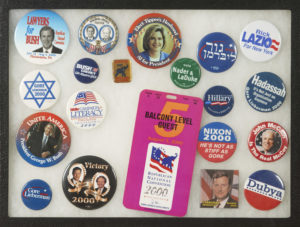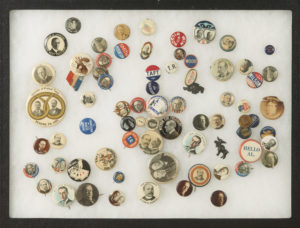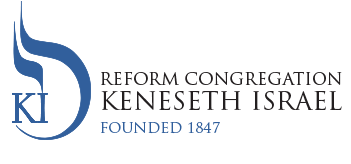In the Temple Judea Museum’s 2012 exhibition, Engaged with Democracy – Our Passions, Our Visions we chose to look at political life, specifically the campaign process, through the lens of a biblically established Jewish affinity to be involved in processes that shape our governance. Now in 2020, during this current presidential campaign we revisit that exhibition. In order to understand the link between Jewish thought and the democratic process one has only to look at Philadelphia’s historic Liberty Bell, commissioned in 1751 to celebrate fifty years of William Penn’s Charter of Privileges, the colony’s law until 1776. The inscription chosen for the bell by a committee of the Pennsylvania Provincial Assembly is, “Proclaim liberty throughout all the land unto all the inhabitants thereof.” from the book of Leviticus 25:10.
EXHIBITION STATEMENT BY RABBI LANCE J. SUSSMAN, PH.D.
Stand Beside Her and Guide Her: Jews, Politics and America
Jewish people have lived in every imaginable polity from clans to tribes; from limited monarchies to empires; from dictatorships of all stripes to democracies. Jews have also supported a wide spectrum of political ideologies and economic philosophies. Jewish people have lived as an autonomous nation, as resident aliens and as enfranchised citizens of non-Jewish states. Today, the largest Jewish community in the world is in the State of Israel and is self-governing. The world’s second largest Jewish community is to be found here in the United States where Jews are a fully enfranchised ethno-religious minority in a remarkably heterogeneous society.
American Jews have been particularly passionate about their involvement in American politics from the arrival of Jews in the Dutch Colony of New Amsterdam in 1654 until today. Touchstones of this involvement include: the first Jewish colonists sustained effort for permission to settle permanently in New Amsterdam; the election of the first Jew to political office in the United States in 1776 (in South Carolina); the first Jew appointed to the Supreme Court; the first Jew to run for Vice President of the United States. Jews have been among the most politically active groups in American history. Jews have been Jeffersonians, Democrats, Republicans, Socialists, Libertarians, Bull Moose Progressives and more. Jews vote in record numbers, work for political campaigns and donate generously to political campaigns at every level of government. Jews even lobby the government of the United States. AIPAC, the pro-Israel lobby, is the leading, but hardly unique, example of American Jewish activism.
Reform Judaism, as a religious movement, has also been politically active for over a hundred years. KI’s own Rabbi David Einhorn was a famous abolitionist. Beginning in the Progressive Era, Reform leaders, both lay and rabbinic, took controversial stands on child labor; separation of church and state; immigration policy; war and peace. The legislation for the Civil Rights Act of 1964 was actually written on the premises of the Reform movement’s Religious Action Center (RAC) in the nation’s capital. The RAC continues to be an integral part of the “Inside the Beltway” scene in Washington to this day.
Politics is not a sport for the fainted hearted. It can be brutal and bruising. But is also an inalienable right for us to participate in the political process as individuals and as members of a small sub-community who proudly call themselves Americans. I was too young to say whether or not “I liked Ike” but I love “I like Ike” buttons, Gene McCarthy buttons and President McKinley buttons. They all point to the same things: our shared democratic values; our belief in the equality of all people in the eyes of the law; and the ongoing, inspiring promise of America! Rabbi Lance J. Sussman, Ph.D.
IMAGES: Political campaign pins from the collection of Flora L. Becker and her husband, the late Judge Edward R, Becker (1933 – 2006). The entire collection is a marvelous record of the elections and political trends of the past one hundred and forty-eight years.


SOME BACKGROUND OF AMERICAN POLITICAL CAMPAIGN BUTTONS
Political buttons were the political advertisements of their day and helped generate name recognition for candidates for public office. They date as far back as President George Washington when sewn on cloth buttons were used. The first mass production of pin-back political campaign buttons, as we know them today, came in 1896 for William McKinley’s campaign for the presidency of the United States. The earliest pin in the Becker Collection dates to the 1840 presidential campaign of William Henry Harrison.
There is a lot to look for in this exhibition. Look for Milton J. Shapp who was the first constitutional governor to be elected to two consecutive terms in Pennsylvania. Shapp, originally Shapiro, changed his name because he was concerned with the prejudice that might result if it was known that he was Jewish. He was also the first Jewish Governor of Pennsylvania.
OTHER PARTS OF THE EXHIBITION: The TJMuseum collection includes the Morris Finkel Memorial Collection of Russian early 20th century political posters. Displayed along with these exceptional and rare posters are two important loaned works from the collection of Lee and Barbara Maimon and a special focus on the groundbreaking Jewish American woman politician from New York, Bella Abzug.
This exhibition demonstrates that political campaigns are about citizens who care passionately about the democratic process. The visual narrative tells of ardent collectors and artists who make the intangibles of doctrines and partisanship a tangible, accessible reality.
